
Fields of Research (FoR)
Biomedical engineering, Pathology (excl. oral pathology), Human biophysicsBiography
Anna is a multidisciplinary, clinically-oriented, scientist. Her research is on the border between experimental pathology and biomedical engineering. Anna’s studies are focused at modelling of the diseases in vitro and in vivo, and morphological validation of new treatment and diagnostic approaches, with a special attention to clinically relevant biomedical engineering solutions. Anna has published more than 60 papers in peer-review...view more
Anna is a multidisciplinary, clinically-oriented, scientist. Her research is on the border between experimental pathology and biomedical engineering. Anna’s studies are focused at modelling of the diseases in vitro and in vivo, and morphological validation of new treatment and diagnostic approaches, with a special attention to clinically relevant biomedical engineering solutions. Anna has published more than 60 papers in peer-review journals, including top journals like Nature Communications, Nanoscale, Nanoresearch, ACS Biomaterials Science & Engineering, etc. Her research contributed to several new clinical applications (in thousands of patients in total), including laser treatment of chronic degenerative cartilage diseases, improved diagnostics of human post-burn skin scars and optimization of severe burns management, surgical correction of scarring alopecia, and a tissue engineering reconstruction of urethra in a patient. Anna’s current work is concentrated at experimental tissue engineering such as creation of 3D engineered organ-specific microenvironments and tumour models applicable both in vitro and in vivo – for basic cancer and cell biology research, testing of drugs, contrast agents, nanoparticles, validation of new bioengineering technologies, and the development of new smart biomaterials for medicine. The most recent Anna's project is focused on the analysis of the biological effects and biomedical applications of magnetic fields.
My Grants
I received funding (grants) for $5.7M in total since 2005 from the following funds: ISTC, RFBR, RSF, INTAS, CRDF, FABLS, Tour de Cure foundation, Macquarie University, ARC, NHMRC, and ACRF.
My Qualifications
BSc, MSc (Human and Animal Physiology and Biophysics), Postgrad. Cert. (Experimental Pathology; PhD level), PhD (Physics)
My Awards
iMQREs scholarship (2014)
MQRF fellowship (2020)
Outstanding Service and Leadership Award, Faculty of Medicine, Health, and Human Sciences, Macquarie University (2024)
My Research Activities
My main fields of research activity are the following:
1. Tissue engineering, tumor tissue engineering and regenerative medicine – development and evaluation of the methods of reconstruction of damaged or lost human tissues and organs (skin, cartilage, urethra, bone; wound healing, burns and scarring; osteochondrosis and articular joints diseases) and modelling of 3D in vitro tissue equivalents (skin; and cancer);
2. In vitro and in vivo models of diseases for biomedical research/engineering purposes (inflammation, degeneration and malignant tumors; tissue reaction on implantation);
3. Functional biomaterials and nanotechnologies for medicine: main – naturally-derived biomaterials and hybrid biosynthetic composites; organ-specific biomaterials, immunomodulatory biomaterials, nanomaterials (upconverting nanoparticles, mesoporous silica nanoparticles; ZnO; PLGA, liposomes); implantable drug delivery systems; bioinks;
4. Morphological diagnostics/ verification, including new noninvasive methods and modelling.
5. Effects of physical factors on tissues (light, electromagnetic fields, ionising radiation, etc.).